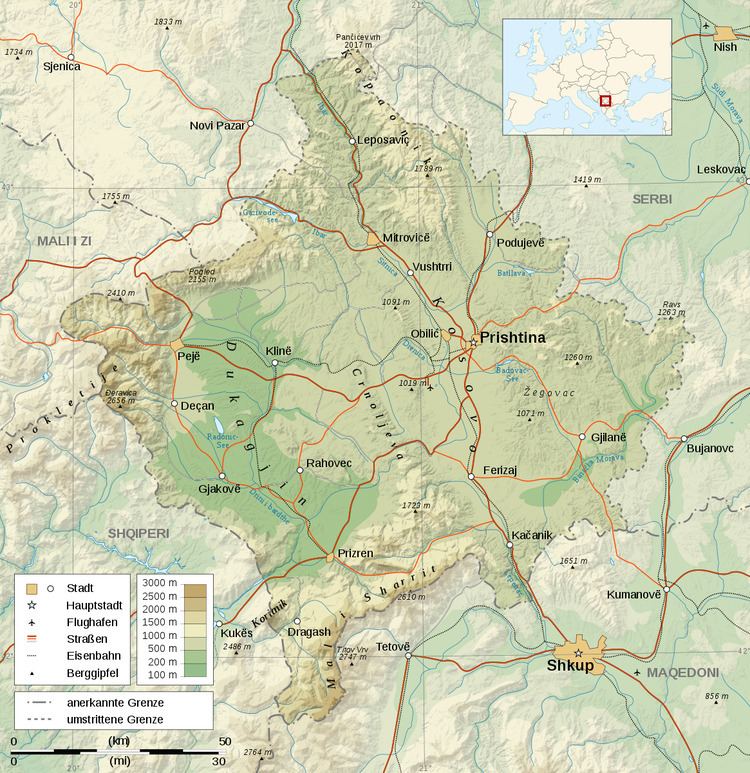 | ||
Transport in Kosovo is complicated by political issues relating to international recognition. The country declared Independence in 2008 from Serbia. It currently has 110 diplomatic recognitions, of which 108 are members of the United Nations. Transport links to the north are fractured as Serbia does not recognise Kosovo's independence. Kosovo is recognised as sovereign by all other countries with which it shares a border. After the Independence, improvements to the road infrastructure, urban transport, and air travel have all led to a vast improvement in transportation. These upgrades have played a key role in supporting Kosovo's economy.
Contents
Road Transport
In recent years, two major road construction spree took place on the main state roads of Kosovo, involving the construction of new roadways, putting of contemporary signs, planting of trees, and related greening projects. Works on two highways are completed.
The R6 Motorway (Albanian: Autostrada Arbën Xhaferi) is a motorway currently under construction. Forming part of the European route E65, it is the second motorway constructed in the region and it links the capital Pristina with the Macedonian border at Hani i Elezit, which is about 20 km (12 mi) from Skopje.
Construction of the motorway started in 2014 and it is going to be finished in 2017-2018.
The R7 Motorway (commonly named the Dr Ibrahim Rugova Highway or simply Albanian: Autostrada Ibrahim Rugova)) is a motorway located in Kosovo. Forming part of the European route E851, it is the first motorway constructed in Kosovo and links the Albanian border, at the village of Vërmicë with the capital Pristina. The construction of the motorway started in April 2010 and was finished in 2013 with the Vërmicë-Pristina segment ending in Gjergjica at the M9.
The highway is seen as part of the larger Vërmicë-Merdare corridor ending at the Merdare border crossing with Serbia in eastern Kosovo. R7 is 101 km long at a cost of €700 million/ $790 million. This highway, along with the A1 Motorway in Albania, have set the travel time from Pristina to Tirana to 3 hours. Once the remaining E80 Pristina-Merdare section project will be finalized and completed, the motorway will link Kosovo through the present E80 highway with the Pan-European corridor X (E75) near Niš, Serbia.
Air Transport
There are three Airports situated in Kosovo, the Gjakova Airport, Batlava-Donja Penduha Airfield and the only international Airport of Pristina. Gjakova's Airport was built by the Kosovo Force (KFOR) following the Kosovo War, next to an existing airfield used for agricultural purposes, and was used mainly for military and humanitarian flights. The local and national government plans to offer Gjakova Airport for operation under a public-private partnership with the aim of turning it into a civilian and commercial airport.
Pristina International Airport is located southwest of Pristina. It is Kosovo's only international airport that handles over 1.75 million passengers per year and the only port of entry for air travelers to Kosovo.
Airports: 10 ; *Airports with paved runways: 4 ; **2,438 to 3,047 m: 1 ; **1,524 to 2,437 m: 1 ; **Under 914 m: 2 ; *Airports with unpaved runways: 4 ; **Under 914 m: 4 ; *Heliports: 2
Rail Transport
The first railway line was built under Turkish guidance for the Compagnie des Chemins de Fer Orientaux (CO), led by Maurice de Hirsch. It started in Thessaloniki, went on north to Skopje and reached Kosovska Mitrovica in 1873. Before the First World War it was used by the Serbian Railways which operated as Yugoslav Railways between 1918 and 1992, and stopped their operations in Kosovo after the NATO intervention in 1999. In 2008 Serbian Railways restored some of its routes in Northern Kosovo region.
Trainkos operates 430 km (267 mi) of railway in Kosovo, of which 333 km (207 mi) serve both freight and passenger and 97 km (60 mi) only serve freight traffic. The non-electrified network originally consisted of two lines crossing at Fushë Kosovë railway station in Kosovo Polje: A main line going from Kraljevo in western Serbia via Kosovska Mitrovica and Kosovo Polje to Skopje in Macedonia, and a branch line in east-west direction from Niš in southern Serbia via Pristina railway station in the capital Pristina and Kosovo Polje with one branch leading to Peć and the other one to Prizren. Of these lines, the one from Pristina to Peć and the one from Kosovo Polje to Macedonia are still served by passenger trains. Some more parts of the network are occasionally served by freight trains, like Kosovo Polje - Obilić; the other parts of the network are currently unused. For years, there have been plans to extend the branch to Prizren across the border to Albania, to create a link to the network of the Hekurudha Shqiptare. However, these projects are no more than letters of intent.
